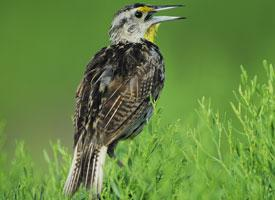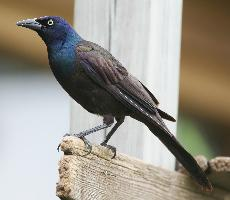
Váhy a míry
| Délka | od 20 do 22,5 cm |
|---|
Popis zvířete
The Eastern Meadowlark (Sturnella magna) is a captivating bird species renowned for its melodious song and striking appearance, embodying the serene beauty of North America's grasslands. This bird, belonging to the Icteridae family, which also includes blackbirds and orioles, is more often heard than seen, its flute-like warble echoing across fields and meadows from Canada to Mexico, signaling the arrival of spring.Physically, the Eastern Meadowlark is a medium-sized bird, with a length ranging from 19 to 28 cm (7.5 to 11 inches) and a wingspan that stretches approximately 35 to 40 cm (14 to 16 inches). It possesses a sturdy build, with strong legs suited for walking and foraging on the ground. One of its most distinguishing features is its bright yellow chest adorned with a bold, black "V" or chevron, which contrasts sharply against its otherwise brown and streaked plumage. This striking pattern not only makes the meadowlark visually captivating but also serves as a deterrent to predators by signaling that it might not be palatable. The bird's face is marked by a distinctive black mask that extends across its eyes, adding to its charismatic appearance.
Eastern Meadowlarks have a diverse diet, feeding on a variety of insects, seeds, and berries. During the summer, their diet primarily consists of insects, including beetles, grasshoppers, and crickets, providing essential protein for their young. In the colder months, they shift towards seeds and grains, foraging on the ground beneath the snow and vegetation. This adaptability in diet plays a crucial role in their survival across the varying climates of their extensive range.
Breeding season for the Eastern Meadowlark begins in early spring and extends into summer. They are polygynous, meaning one male typically mates with multiple females. The female builds a remarkable ground nest, intricately woven from grasses and cleverly concealed under a canopy of vegetation to protect it from predators. The nest's entrance is often oriented towards the south or southeast, possibly to maximize warmth from the sun. The female lays a clutch of 3 to 5 eggs, which she incubates for about two weeks. Once hatched, the chicks are altricial, requiring several weeks of care before they can leave the nest.
Despite their beauty and the joy their songs bring to many, Eastern Meadowlarks face significant challenges. Habitat loss due to agricultural expansion, urban development, and the intensification of farming practices poses the most significant threat to their populations. Conservation efforts are crucial to preserving the grassland habitats these birds rely on, not only for the meadowlarks but for the entire ecosystem that benefits from their presence.
In summary, the Eastern Meadowlark is a symbol of the open grasslands of North America, with its vibrant yellow chest, melodious song, and intricate behaviors. Its presence enriches the landscapes it inhabits, making it a species worthy of admiration and protection.
Podobná zvířata
Nové fotografie zvířat
Top 10 zvířat
- Chinese water dragon (Physignathus cocincinus)
- Galápagos tortoise (Geochelone nigra complex)
- Dolphin gull (Leucophaeus scoresbii)
- Japanese macaque (Macaca fuscata)
- Colombian red howler (Alouatta seniculus)
- Sea urchins (Echinoidea)
- Moustached guenon (Cercopithecus cephus)
- Diana monkey (Cercopithecus diana)
- Common reed warbler (Acrocephalus scirpaceus)
- Common house mosquito (Culex pipiens)
